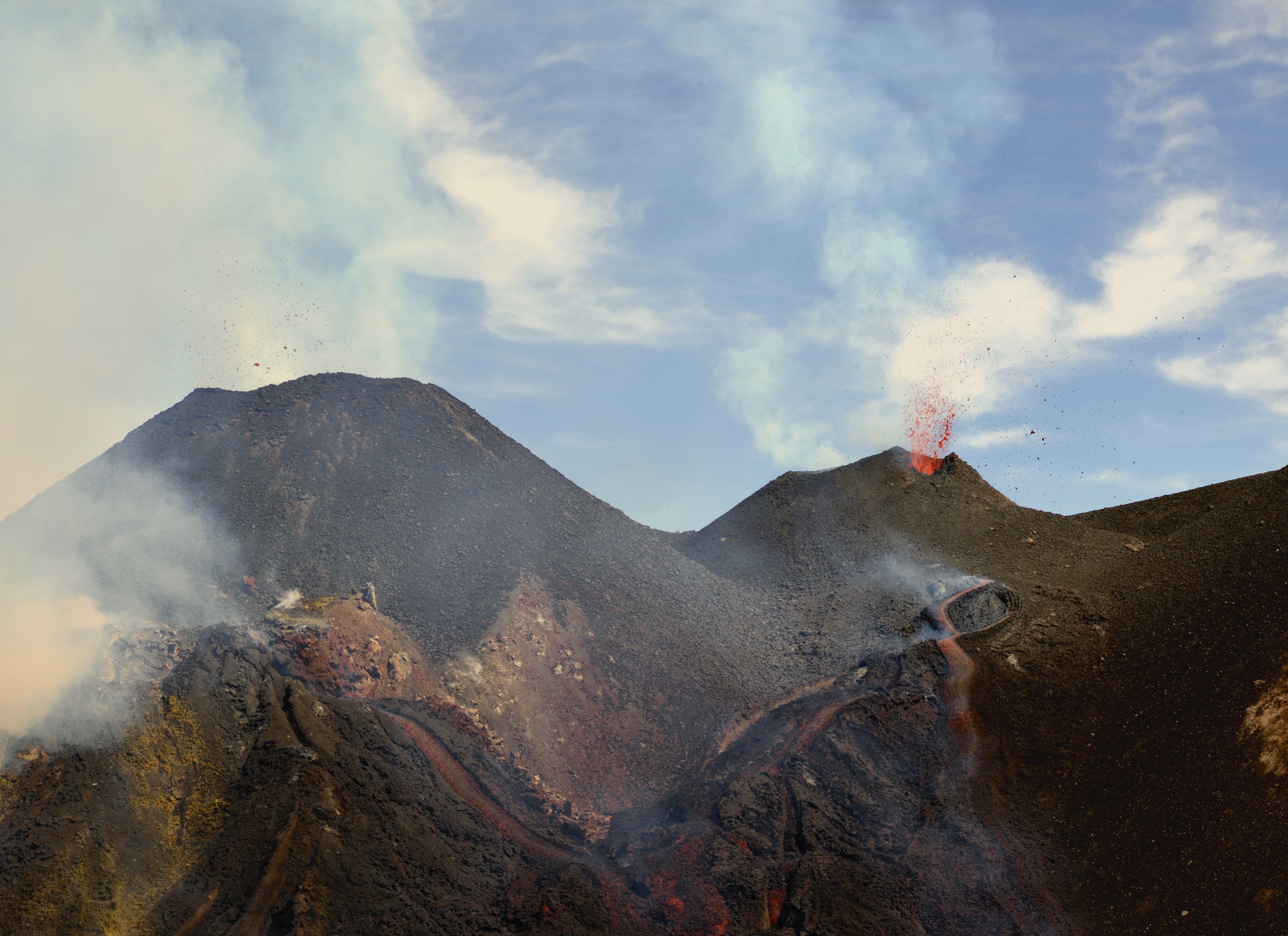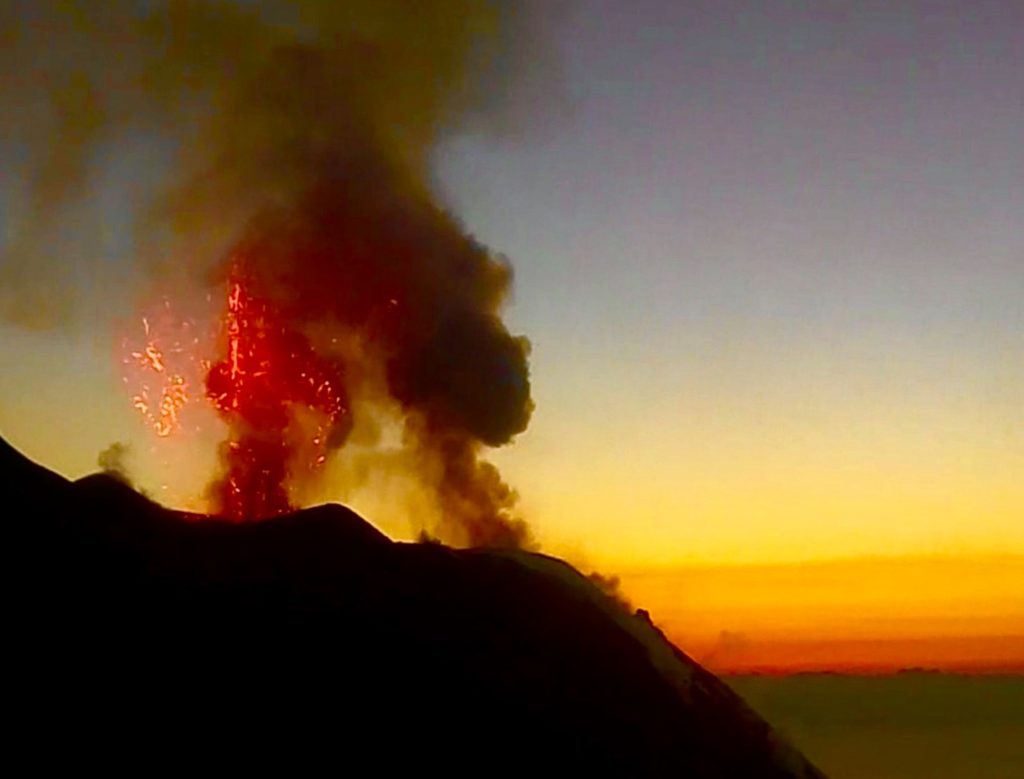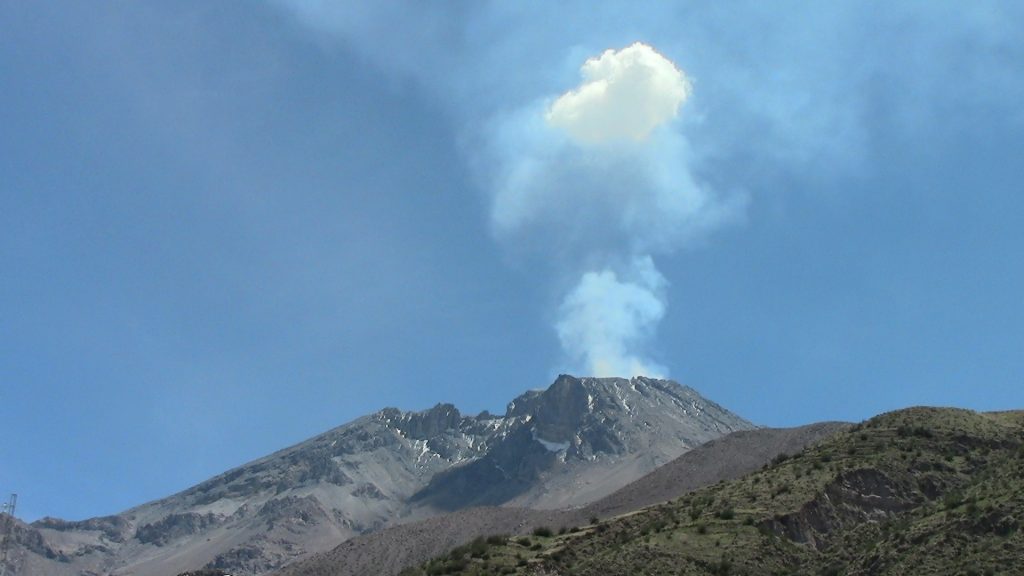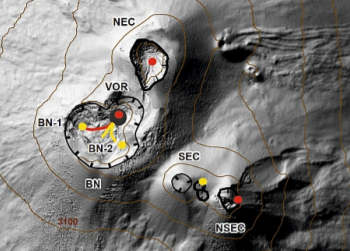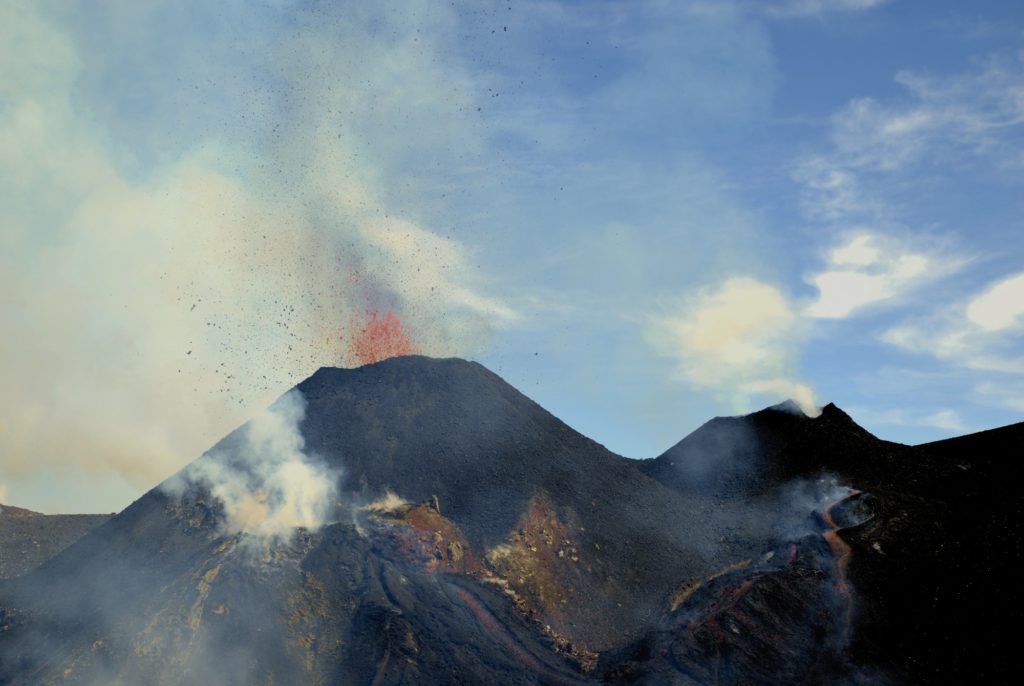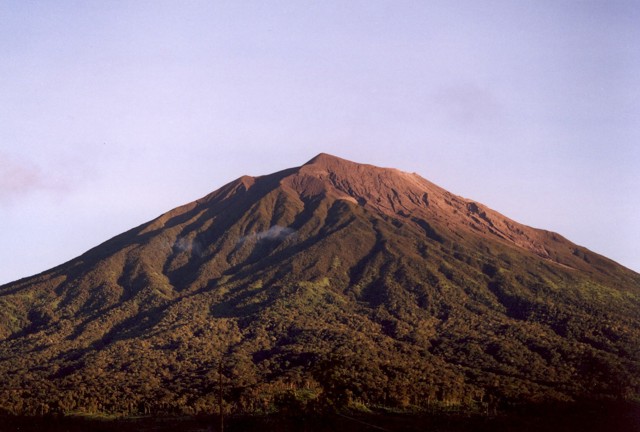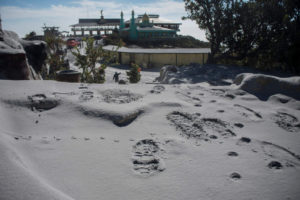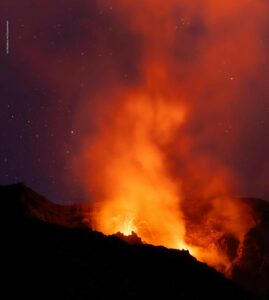March 25 , 2020 .
Italy , Stromboli :
Weekly bulletin from 16/03/2020 to 22/03/2020 (date of issue 24/03/2020).
SUMMARY OF THE ACTIVITY
In light of the monitoring data, it is highlighted:
1) VOLCANOLOGICAL OBSERVATIONS: During this period, a normal explosive activity of strombolian type was observed accompanied by a degassing activity. The hourly frequency of explosions fluctuated between average values (14 events / h on March 22) and high values (25 events / h on March 17). The trend in frequency values showed a gradual decrease from 25 to 14 events / h. The intensity of the explosions was mainly medium-low in the area of the North crater and medium-high in the area of the Center-South crater.
2) SEISMOLOGY: The seismological parameters do not show significant variations.
4) DEFORMATIONS: The Stromboli soil deformation monitoring networks did not show any significant changes for the period considered.
5) GEOCHEMISTRY: The flow of SO2 is at an average level. The last value of the CO2 / SO2 ratio is at an average value (last update of 02/09/2020). There are no other updates. The value of the isotopic ratio of helium dissolved in the aquifer is at an average level (last update of 09/03/2020).
6) SATELLITE OBSERVATIONS: Slight increase in thermal activity in the summit area which reaches a medium-low level.
VOLCANOLOGICAL OBSERVATIONS:
The analysis of the images recorded by the cameras placed at an altitude of 400m, at an altitude of 190m and at Punta dei Corvi made it possible to characterize the eruptive activity of Stromboli. During the reporting period, the explosive activity was mainly produced by at least 3 (three) eruptive vents located in the area of the North crater and by at least 3 (three) eruptive vents located in the area of the Center-South crater . All the mouths are placed inside the depression which occupies the crater terrace.
In the northern zone, the explosions were mainly of variable intensity, from low (less than 80 m in height) to high (more than 150 m in height), emitting coarse materials (lapilli and bombs). In numerous explosions, the abundant fallout covered the outer slopes of the area overlooking the Sciara del fuoco and the blocks rolled until they reached the coast. It should be noted that on March 19 from 2:50 p.m. UTC and until 4:30 p.m. UTC, from one of the two northern mouths located on the edge of the North crater area, overlooking the Sciara del Fuoco, an intense activity of splashes which produced a modest rheomorphic flow which extended in the upper part of the Sciara for a few hundred meters. The average frequency of explosions in the North zone varied between 7 and 9 events / h. The explosive activity of the Center-South zone produced explosions of mainly fine materials (ashes) mixed with coarse materials, with an average intensity (less than 150 m in height) sometimes high (the products exceeded 250 m in height) . The frequency of explosions in the Center-South zone varied between 5 and 16 events / h.
The amplitude of the volcanic tremor generally had medium-low values, with some oscillations at medium-high values on days 17-18 / 03 and 20/03. … / …
Source : INGV.
Read the whole article : file:///C:/Users/Utilisateur/AppData/Local/Packages/Microsoft.MicrosoftEdge_8wekyb3d8bbwe/TempState/Downloads/BollettinoStromboli20200324%20(1).pdf
Peru , Ubinas :
Analysis period: March 16 to 22, 2020. Arequipa, March 23, 2020.
Alert level: ORANGE
The Geophysical Institute of Peru (IGP) reports that the eruptive activity of the Ubinas volcano remains at low levels. To date, the recording of earthquakes associated with the rise of magma to the surface is rare. Likewise, there are light and sporadic emissions of bluish gases (of magmatic origin) and water vapor. According to this scenario, the possibility of volcanic explosions and / or ash emissions is low.
The IGP recorded and analyzed a total of 106 seismic events associated with the dynamic behavior of the Ubinas volcano, with the predominance of volcano-tectonic signals (VT), related to the fracturing of the rocks inside the volcano. On average, 7 earthquakes were recorded per day with magnitudes below M1.2. The seismic activity linked to the rise of magma (hybrid type) decreased as much in the number of events (3 daily earthquakes) as in their energy.
Surveillance cameras recorded light and sporadic emissions of volcanic gases and water vapor, with heights less than 300 m above the summit of the volcano. Monitoring the deformation of the volcanic structure does not record any significant anomalies. MIROVA satellite monitoring did not record any thermal anomalies.
On March 18 at 4:20 p.m., the descent of a low-risk lahar into the Volcanmayo gorge was recorded. The alert information was disseminated via the Volcanes Perú mobile application and communicated by telephone to the Technical Secretary of Civil Defense of the municipality of the district of Ubinas.
Source : IGP
Photo : Unknown author
Italy / Sicily , Etna :
Weekly bulletin from 16/03/2020 to 22/03/2020 (date of issue 24/03/2020).
SUMMARY OF THE ACTIVITY
In light of the monitoring data, it is highlighted:
1) VOLCANOLOGICAL OBSERVATIONS: Strombolian and effusive intra-crater activity of the Voragine crater. Degassing of the Northeast Crater and the New Southeast Crater
2) SEISMOLOGY: Modest seismic fracturing activity; high values of the amplitude of volcanic tremor
3) INFRASOUND: moderate infrasound activity
4) DEFORMATIONS: The Etna soil deformation monitoring networks did not show any significant changes last week.
5) GEOCHEMISTRY: the flow of SO2 is at a medium-low level. Soil CO2 flow values are low to medium. The partial pressure of dissolved CO2 does not show significant variations. The isotopic ratio of helium is fixed at medium-high values (last update of 2/14/2020). No update on the CO2 / SO2 ratio is available.
6) SATELLITE OBSERVATIONS: Intensification of thermal activity in the summit area which reaches a moderate level.
VOLCANOLOGICAL OBSERVATIONS:
During the week, monitoring of Etna’s volcanic activity was carried out by analyzing the images acquired by the network of INGV surveillance cameras from the Catania section, the Etneo Observatory (INGV-OE) and thanks to an inspection carried out on March 19, during which videos and photos of the eruptive activity were acquired. Samples of eruption products were taken.
During the inspection, the persistence of an eruptive activity of the Voragine crater (VOR) and an abundant degassing activity of variable intensity of the North-East craters (NEC) and of the New South-East crater were observed (NSEC), both also characterized by pressurized gas emissions accompanied by sporadic roars. The crater of Bocca Nuova (BN) following the spillage of the flows produced by the activity of Voragine, has lost the characterization of the location of mouths BN1 and BN2, and has only a fumarol degassing distributed along inside the south-eastern intra-crater zone.
Concerning the eruptive activity of the Voragine crater, the lively Strombolian type activity described in the bulletin Rep. N ° 12/2020 continues and is produced by two separate slag cones. In the main cone, active since September 12, 2019, the explosive activity was generated by a single mouth located in its summit crater and characterized by an almost continuous splashing activity with bombs and shreds of lava launched a few dozen meters high and sporadic explosions of high intensity with throws of more than 100 meters which still emitted lapilli and ash, interspersed with a few tens of minutes from each other. The second and smallest slag cone, located East-South-East compared to the previous one, was characterized by a lively and persistent explosive activity produced by the two largest mouths already active during the reconnaissance of March 14, and placed on the top of the other cone just north and below. The two mouths produced continuous splashes of a few minutes, sometimes simultaneously from the two mouths, interspersed with stronger explosions of bombs and shreds of lava that could reach several tens of meters high.
Along the southeast flank of the main cone, the effusive activity emitted by a mouth placed on a large mound continued, to which was joined a second flow of lava which came out of a mouth placed at the base of the second cone at an altitude of a few tens of meters higher. From this mouth, inactive on March 14, a second lava flow came out which widened the lava field to the South forming a complex range of lava flows and tunnels which reached the bottom of the Bocca Nuova while continuing to fill the depression of the crater. Overall, the effusive activity was much more intense and extensive than that observed on March 13, qualitatively at least doubled.
Composition of thermal images of the eruptive activity of Voragine taken during the inspection of March 19 from the southern edge of the Bocca Nuova, showing the slag cones, the structure of the mound and the mouths and effusive flows which are spill inside the Bocca Nuova (images by S. Branca)
During the inspection, the spatial arrangement and the characteristics of the slag cones were observed from the northern edge of the Voragine crater. The third ash cone observed on March 13 and described in the bulletin Rep. No. 12/2020, is located northeast of the main cone and northwest of the second cone and at the time of the observations it was still inactive outside a few sporadic puffs of gas. Finally, from the northern edge, it was possible to estimate the maximum height reached by the main cone (cone of September 12, 2019) which exceeded the highest point of the crater edge between Voragine and Bocca Nuova at a altitude of 3270 m, probably reaching 3300 m altitude, while the second cone stopped at an altitude of about 30 m lower.
Source : INGV.
Read the whole article : http://www.ct.ingv.it/joomlatools-files/docman-files/multidisciplinari/BollettinoEtna20200324.pdf?fbclid=IwAR1qMvFiZFjRb-cGPZgkxwHDCdOlp2j5yUfLLKWWnc0_RLu4Tp0GomlT96Q
Photos : INGV , Boris Behncke , S. Branca .
Indonesia , Kerinci :
VOLCANO OBSERVATORY NOTICE FOR AVIATION – VONA.
Issued: March 25 2020
Volcano: Kerinci (261170)
Current Aviation Colour Code: YELLOW
Previous Aviation Colour Code: yellow
Source: Kerinci Volcano Observatory
Notice Number: 2020KER13
Volcano Location: S 01 deg 41 min 49 sec E 101 deg 15 min 50 sec
Area: Jambi, West Sumatra, Indonesia
Summit Elevation: 12176 FT (3805 M)
Volcanic Activity Summary:
On 25 Maret 2020, observed brown ash emission at 22:59 UTC ( 05:59 Local Time )
Volcanic Cloud Height:
Best estimate of ash-cloud top is around 13776 FT (4305 M) above sea level, may be higher than what can be observed clearly. Source of height data: ground observer.
Other Volcanic Cloud Information:
Ash emission moving West – Southwest.
Remarks:
Seismic activity is dominated by gas emission and continuous vulcanic tremor with amplitude 0,5-1 mm (dominan 1mm).
Source : Magma Indonésie.
Photo : Umar Rosadi, 2005 (Center of Volcanology & Geological Hazard Mitigation, Volcanological Survey of Indonesia).

